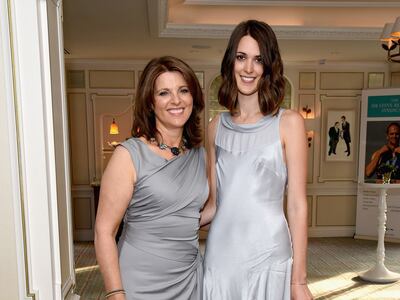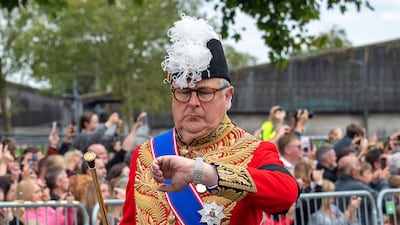The death of Queen Elizabeth II a year ago triggered Operation London Bridge – the royal funeral plan – and brought to the fore the man entrusted with the official commemoration, who this week recalled how he had worked on the arrangements for decades.
The intricate protocol ranged from succession rules to the process of bringing the Queen’s coffin from Balmoral in Scotland to London, the laying-in-state for thousands to pay respects and the final funeral processions from Westminster to Windsor.
The funeral was the responsibility of the Earl Marshal, Edward Fitzalan-Howard. The 18th Duke of Norfolk is the most senior peer in Britain by ranking. The hereditary responsibility of the family is to organise major ceremonial occasions, which this year also extended to King Charles III’s Coronation.
More than 250,000 people queued to see the Queen lying in state, the queue was 10 miles long at its peak, with people waiting for 24 hours to gain entry to Westminster Hall to view the Queen’s coffin. More than 28 million people watched proceedings on TV in the UK and more than four billion watched worldwide. Nearly 6,000 military personnel took part in ceremonies from her death to her burial and more than 10,000 police officers were enlisted for the funeral day.
Almost 2,000 mourners received invitations for Westminster Abbey, including presidents Joe Biden, Emmanuel Macron and the Emperor of Japan. Every detail was thought through, and even the Queen’s corgis, Muick and Sandy, and one of her ponies were led out to witness the funeral cortege at Windsor.
The Duke of Norfolk is quick to say the extraordinary spectacle of the funeral was a joint effort. He tells The National: “I started planning on the state funeral 20 years ago, after the death of my father, and my staff officer at that time, Colonel Anthony Mather, had been in command of the bearer party at Sir Winston Churchill’s funeral, so he’d had valuable experience of a big state funeral. At my very first meeting there were 12 people, by the last meeting in 2022 there were 282 attending, so we were in an advanced state of readiness.”
He explains that there were plans prepared for Her Majesty’s death in any one of the royal residences, or even in a private home. He admits he was nervous until the last minute. “I knew if I got it wrong, I would probably have to emigrate”, he said, but had huge faith in the “inner sanctum” of 40 people powering the proceedings along.
At one moment during the funeral the duke admits he had to make an immediate decision. “I felt my father behind me. He’d fought at Dunkirk and had been awarded a Military Cross. I could hear him say to me: ‘Eddie, you’re in charge, take command!’”
The duke is probably most proud of the fact that he and his latest staff officer, Major Anthony Chatburn, included the opportunity for every single serviceman, including those from the Commonwealth, to see the Queen’s coffin. “At Churchill’s funeral, servicemen didn’t get this chance. I’m very glad we did that.”
Last year, the duke’s niece, Lady Kinvara Balfour, said: “In organising the Queen’s funeral, Uncle Eddie has done a truly outstanding job. What a show of elegance, efficiency and rare precision he has produced for our nation and the world”.
The duke’s wife, the Duchess of Norfolk, enjoyed meeting the Queen in a private capacity. “The Queen’s love of horses, and riding them all her life, was well-known and I was privileged to go on a ride alone with her,” Chica Norfolk recollected.
“I was staying at Windsor Castle for Royal Ascot in June and Her Majesty asked if I wanted to ride in the morning. We set off together and rode across the beautifully manicured lawns. I was given one of her granddaughter Zara Tindall’s horses.”
Queen Elizabeth’s love of nature was also well-known, favouring her properties in Sandringham in Norfolk, Balmoral in Scotland and Windsor Castle over Buckingham Palace in London.
“While riding along the riverbank, we happened upon a mother swan swimming in the Thames, encouraging her cygnets to jump the 3ft into the water, clearly for the first time after leaving their nest,” the duchess recounted.
“One at a time they joined their mother. We sat on our slightly fidgety horses, watching for over 30 minutes while talking about the magnificence of nature and love of the countryside. She was so interesting to talk to and so interested to hear my news.”

The Duchess of Norfolk’s final memory is of a monarch who was a delightful guest. “She would come for lunch annually in April and when the lunch happened to be on her real birthday, my children brought in a cake singing ‘Happy Birthday’. We all joined in with the singing and she appeared delighted. After every lunch, we would move next door for coffee to the sitting room. She had a warmth about her that put fellow guests at ease with a ready smile and gentle manner.”
On the first anniversary of the death, TV screens will replay the touching final pictures that simultaneously recall her physical frailty, her indomitable spirit and, most of all, the incandescence of her smile as she gave an audience to new Prime Minister Liz Truss, her last public duty. It was evident Her Majesty was nearing the end of her days and she died 48 hours afterwards.
With hindsight, the contrast of Ms Truss’s chaotic and short-lived premiership, with the orderly and dedicated reign of the Queen, who became the longest-reigning monarch in history and who was determined to execute her duties until two days before her death aged 96, is striking.
'Humanity and sympathy'
Ms Truss’s predecessor, Boris Johnson, whose resignation as Prime Minister the Queen had received just before meeting Ms Truss, says he still thinks of her daily. “How often I think of the Queen, even though it is now a year since she died.”
He looks back on their last conversation, the day he ceased to be Prime Minister. “She knew in that summer of last year that her health was now failing, but she was determined to do her job as monarch, to hang on until she had performed the crucial function of seeing off her 14th UK Prime Minister and making sure that there was a peaceful and orderly transition to the 15th.
“She succeeded in that, as in so much else, because she believed that by willpower and energy, we can shape our ends and transform our fortunes: a lesson this country perhaps needs to remember these days.”

He has considered what made Her Majesty unique. “It was because of her humanity and sympathy that you felt, as PM, that you could really open up to her, tell her absolutely everything, so that the audiences were a mixture between a tutorial and a confessional, with a bit of unpaid psychotherapy thrown in.”
The grief at the loss of the long-reigning monarch a year ago was very different than that demonstrated at the death of Princess Diana nearly 30 years earlier – then a mixture of raw emotion and disbelief - but the deep sense of heartfelt and profound loss was far more fitting for the late Queen. Many of whom mourned had never known another sovereign and, as many admitted, there had been an entirely unreasonable but sincere belief that she would “go on forever”.
Ultimately former Prime Minister Johnson and the Duke of Norfolk echo each other somewhat. Mr Johnson summarises Her Majesty’s own philosophy saying she believed, “no disaster is ever really irretrievable, just as no triumph is ever final, and that in their natural resilience and genius the British people would get through anything, provided – and this was the key point – there was the right spirit of duty and service and effort, virtues which she exemplified all her life.”
The duke says the late Queen’s funeral was more than a beautifully orchestrated public event: “It showed what pride we can take in Britain, what a great nation we are and what incredible values we do have.”




































